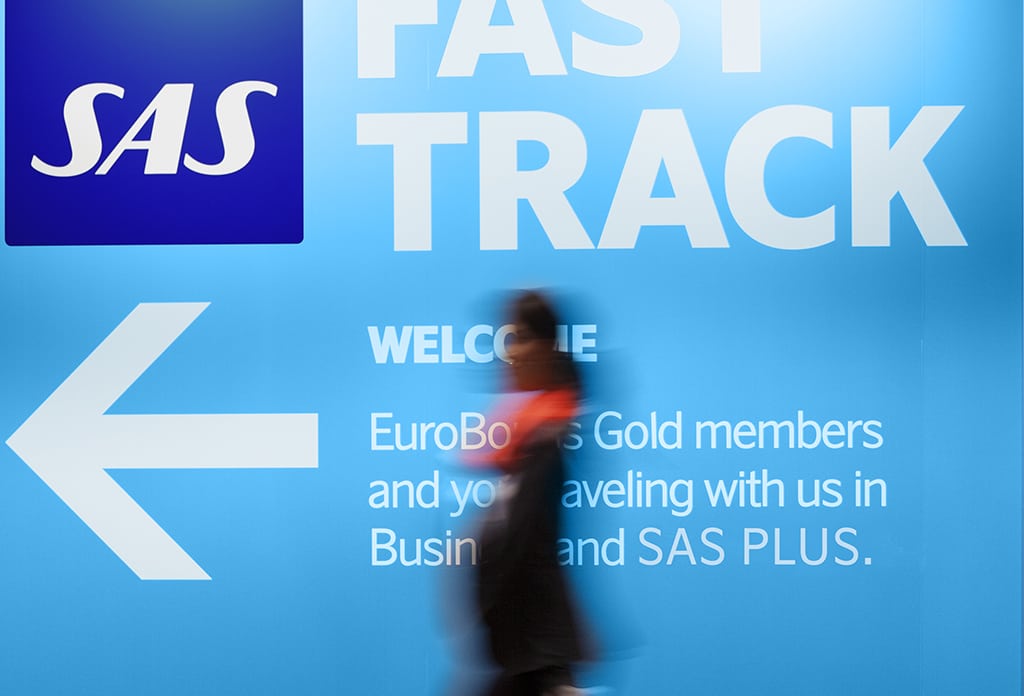Skift Take
All airlines are in a transition period now, and SAS's changes are indicative of how legacy airlines are adapting.
Snorre Andresen, Head of Product and Development at Scandinavian Airlines (SAS), believes that the future of passenger experience improvement is to put passengers fully in control of their journey.
SAS’s customers, he tells us, “enjoy doing practical things themselves.” He describes the basis of their strategy for passenger experience improvement as “maximizing and optimizing self-service products.” Andresen indicates that 80% of the airline’s customers opt for self-service.
As Andresen explains, SAS begins by focusing on some very basic service requirements: allowing passengers to skip queues and eliminating non-value-adding customer touch points. To accomplish this, SAS have focused on enhancing their digital platforms.
Massimo Pascotto, Head of Innovation and Digital Solutions for SAS, tells us that those digital platforms are focused around ensuring a smooth and responsive customer experience. Because 60% of the airline’s bookings are done through travel agencies and 40% from their web and mobile apps, SAS have focused on developing systems which ensure that passengers can find details on their reservation regardless of how the booking was made. They have also worked to encourage more direct sales by introducing full booking capability to their app.
Pascotto tells us that they’ve focused their passenger digital services on “immediacy, intimacy and individualism,” echoing Andresen’s point that SAS customers prefer to do things themselves.
Both explain that SAS have enhanced their digital services on the ground through an effective web booking interface, which accommodates the needs of passengers regardless of their IT proficiency, and at the terminal with enhanced kiosk-based check-in, automated turnstiles, and numerous digital customer information and service touch points to improve way-finding.
Many airlines, including SAS’s Star Alliance partners, have incorporated these technologies; but for SAS establishing an effective passenger electronic interface and coordinating with main-hubs presents a particular challenge.
Andresen makes light of the complexities of coordinating an airline which represents three sovereign nations with their own, though related, languages and cultures. He focuses on passengers as globally, telling us that SAS’s drive to “make life easier [for passengers] is not related to the color of their passport.”
Still, the airline must juggle three main hubs with very distinct markets, and ensure a consistent travel experience. “Norway is hugely domestic,” Andresen explains. Because of the unique geography of the nation, and the remoteness of many towns, Norwegians travel mostly by air to visit friends and family or to do business within Norway.
Kastrup CPH is on the other extreme, with a small domestic market and a very large international market. All three main hubs, OSL, ARN, and CPH are dynamic markets from SAS’s perspective.
After coming out of difficulties through an effective reorganization under the leadership of CEO Rickard Gustafson, the airline is ready to grow, but focused on what Andresen describes as “dynamic healthy growth.”
SAS focuses on “relevant scalability [of their infrastructure] in all markets, at all airports,” Andresen says.
The main focus of the airline’s contribution to airport planning is to ensure their customers have lounge facilities and Fast-Track clearance available, and that the infrastructure of the airport supports their preference for a digital self-service platform. They count on their hub partners to be as self-reliant as their passengers, and trust them to plan adequate growth to support market demand with little intervention from the airline.
Speaking of their terminal lounges, Andresen makes the point that the standard of design for SAS is “a nice place for our passengers to work, and relax; where passengers can find adequate facilities but not extreme luxury because our passengers don’t want that.”
Productivity is of critical importance for SAS passengers, and the airline ensures there are abundant plugs available to power devices at their lounges and free WiFi. Additionally, passengers will find healthy meals options at the buffet, plenty of fruit, and a wide assortment of refreshments. The decor is simple and functional, in keeping with a Scandinavian aesthetic.
This is the same aesthetic which, Pascotto tells us, they have applied to the design of their digital interface; focusing on a modern flat design, simple intuitive interface and consistent UX across platforms.
All of it comes together both to address the needs of SAS passengers for independence and to support the airline’s basic business platform which Andresen describes as “not jumping at trends.”
The airline has announced an introduction of a new cabin design coming shortly, and while we may expect it to be comfortable and elegant; one might suppose it will be in keeping with this same, very Scandinavian, understated and modern standard.
To the airline, like the region, modernity is characterized by simplicity. As SAS sees it, the best way to guarantee simplicity for their passengers is to provide them the necessary and effective digital tools to manage the journey for themselves.
The Daily Newsletter
Our daily coverage of the global travel industry. Written by editors and analysts from across Skift’s brands.
Have a confidential tip for Skift? Get in touch
